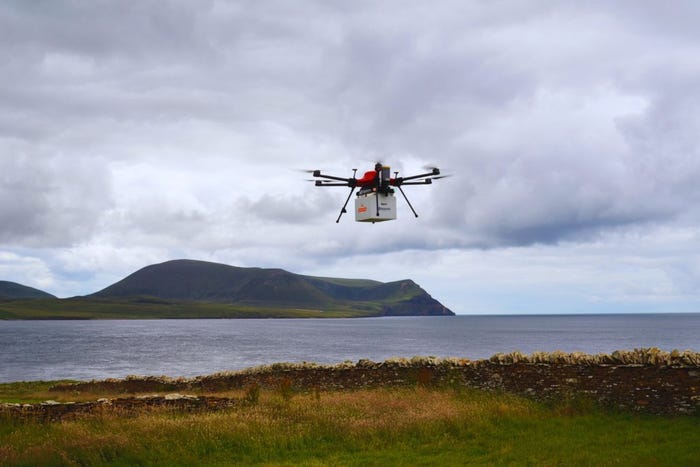Royal Mail begins drone delivery service in OrkneyRoyal Mail begins drone delivery service in Orkney
The Orkney I-Port operation, run by Royal Mail and Skyports Drone Services, establishes a daily inter-island mail distribution service between three islands on Orkney.
August 1, 2023

The Orkney I-Port operation, run by Royal Mail and Skyports Drone Services, establishes a daily inter-island mail distribution service between three islands on Orkney.
Letters and parcels will be transported in the usual fashion from Royal Mail’s Kirkwall delivery office to Stromness, where Skyports Drone Services will then send out drone deliveries to Royal Mail staff on Graemsay and Hoy, who can then deliver them to homes and businesses.
The daily mail distribution service between the islands will initially operate for three months but the intention is to extend it. Royal Mail says it is the first UK drone delivery project which can be conducted on a permanent basis under existing regulatory frameworks, thanks to the ‘unique landscape of Orkney and the proximity of the islands to one another.’
This, we’re told, allows the drones to use visual line of sight (EVLOS) permissions rather than beyond visual line of sight (BVLOS) permissions.
The post-drone in question is a Speedbird Aero DLV-2 aircraft, a multirotor drone capable of carrying payloads of up to 6kg. Using drones is particular handy in Orkney apparently because the usual method of transporting mail over ferry can be disrupted due to poor weather, which they get a lot of, so this is supposed to significantly shorten delivery times to Graemsay and Hoy.
“By leveraging drone technology, we are revolutionising mail services in remote communities, providing more efficient and timely delivery, and helping to reduce the requirement for emissions-producing vehicles,” said Alex Brown, Director, Skyports Drone Services. “We’re pleased to once again be partnering with Royal Mail to demonstrate how drone operations can benefit UK logistics on this project. The I-Port project also marks an exciting milestone as it is the first operation we are completing with aircraft partner Speedbird.”
Rt. Hon. Alistair Carmichael MP for Orkney and Shetland added: “I was glad to attend the drone tests and see their development for myself. Obviously these schemes are still at trial stage and so we should temper our expectations. Even so anything that helps to maintain the universal service, especially in areas of the isles which are more difficult to reach, is something that we should give a chance to support. Royal Mail remains a critical part of keeping the isles connected – and local knowledge and care are vital to that network.”
Skyports received £150,000 to test Orkney I-Port operation as a part of the Freight Innovation Fund Accelerator, a programme funded by the Department for Transport.
It sounds like a modest but tangible example of how drones could have a role in all sorts of arenas – and presumably the people of Orkney will be glad to receive mail more promptly when the weather is kicking off.
In a similar sense, BT and satellite firm OneWeb recently hooked up remote island of Lundy off Devon to the internet via satellite, in what they said was the ‘first real-world example’ of this sort of deployment to connect remote areas.
Both projects claim to be firsts of a sort, and both have the benefit of being practical deployments using cutting edge tech to do a useful job, as opposed to a technical trial in a lab. However how the drone and LEO connectivity sectors expand beyond remote deployments and into fully fledged industries will be the interesting thing to watch.
In the case of drones, there appear to be some regulatory barriers which the release alludes to by pointing out the unique geography of the islands means it can use EVLOS rather than BVLOS permissions.
A recent report from BT and GSMA argued that new regulations are needed to help the UK drone industry keep pace with the rest of the world – claiming policies around BVLOS drones are confusing to firms looking to develop them, the implementation guidelines need to be simplified and modernised, and drone firms should have a say in regulatory development.
Similarly in January, The Drone Delivery Group submitted a white paper to the government urging changes in established air, sea and land transport regulations that could apparently stifle the burgeoning drone sector in the UK. It suggested some more joined up thinking regarding transportation laws that might affect commercial drones in the future, calling for ‘a harmonised and coordinated approach to standards and regulations, across land, sea and air.’
There are moves being made towards a more larger scale commercial drone deployments, such as the ‘UK’s drone superhighway’, or Project Skyway. This is a a 165-mile drone corridor spanning airspace above Reading, Oxford, Milton Keynes, Cambridge, Coventry, and Rugby, which BT (who has put £5 million into it) describes as the largest and longest network of drone superhighways in the world – though of course it hasn’t been built yet.
There is a PWC stat often trotted out by firms evangelising for drone tech which says the ‘drone contribution to the UK economy’ will be £45 billion by 2030. As stated, the Orkney drone project is laudable for being active and of real-world use to some people, but it seems the government and commercial parties concerned need to get their ducks in a row in terms of how the concept could be quickly and safely scaled up if these lofty figures are to be reached by 2030.

Get the latest news straight to your inbox. Register for the Telecoms.com newsletter here.
About the Author
You May Also Like










.png?width=300&auto=webp&quality=80&disable=upscale)


_1.jpg?width=300&auto=webp&quality=80&disable=upscale)